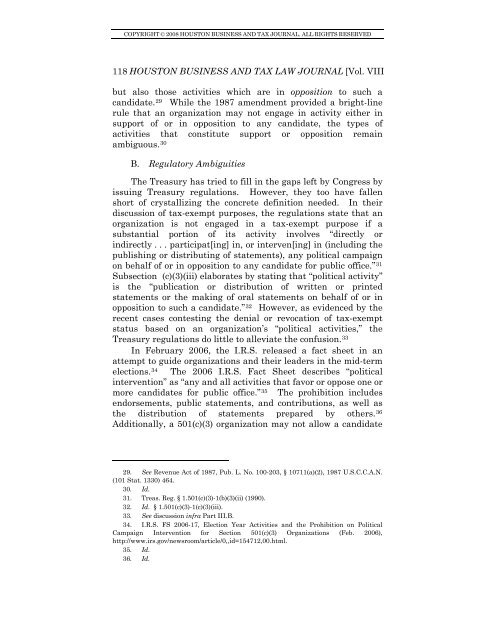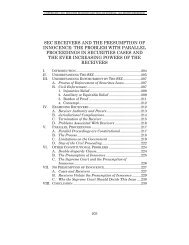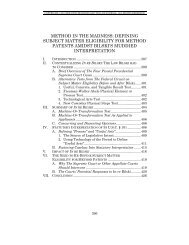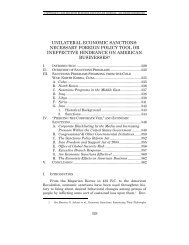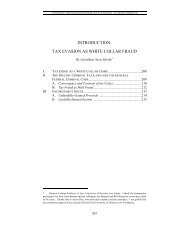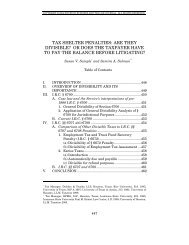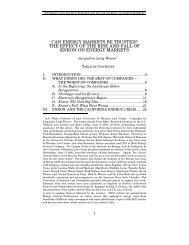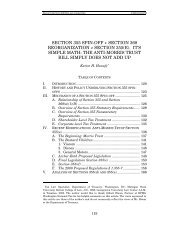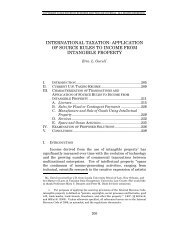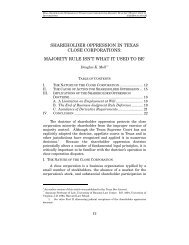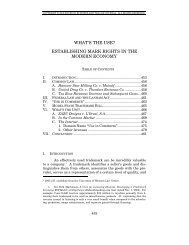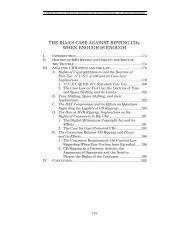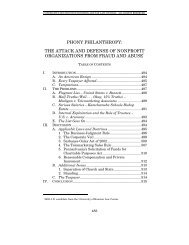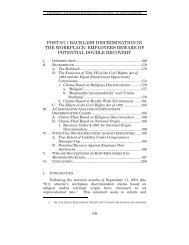Eyes Wide Shut: The Ambiguous ?Political Activity? - Houston ...
Eyes Wide Shut: The Ambiguous ?Political Activity? - Houston ...
Eyes Wide Shut: The Ambiguous ?Political Activity? - Houston ...
Create successful ePaper yourself
Turn your PDF publications into a flip-book with our unique Google optimized e-Paper software.
COPYRIGHT © 2008 HOUSTON BUSINESS AND TAX JOURNAL. ALL RIGHTS RESERVED<br />
118 HOUSTON BUSINESS AND TAX LAW JOURNAL [Vol. VIII<br />
but also those activities which are in opposition to such a<br />
candidate. 29 While the 1987 amendment provided a bright-line<br />
rule that an organization may not engage in activity either in<br />
support of or in opposition to any candidate, the types of<br />
activities that constitute support or opposition remain<br />
ambiguous. 30<br />
B. Regulatory Ambiguities<br />
<strong>The</strong> Treasury has tried to fill in the gaps left by Congress by<br />
issuing Treasury regulations. However, they too have fallen<br />
short of crystallizing the concrete definition needed. In their<br />
discussion of tax-exempt purposes, the regulations state that an<br />
organization is not engaged in a tax-exempt purpose if a<br />
substantial portion of its activity involves “directly or<br />
indirectly . . . participat[ing] in, or interven[ing] in (including the<br />
publishing or distributing of statements), any political campaign<br />
on behalf of or in opposition to any candidate for public office.” 31<br />
Subsection (c)(3)(iii) elaborates by stating that “political activity”<br />
is the “publication or distribution of written or printed<br />
statements or the making of oral statements on behalf of or in<br />
opposition to such a candidate.” 32 However, as evidenced by the<br />
recent cases contesting the denial or revocation of tax-exempt<br />
status based on an organization’s “political activities,” the<br />
Treasury regulations do little to alleviate the confusion. 33<br />
In February 2006, the I.R.S. released a fact sheet in an<br />
attempt to guide organizations and their leaders in the mid-term<br />
elections. 34 <strong>The</strong> 2006 I.R.S. Fact Sheet describes “political<br />
intervention” as “any and all activities that favor or oppose one or<br />
more candidates for public office.” 35 <strong>The</strong> prohibition includes<br />
endorsements, public statements, and contributions, as well as<br />
the distribution of statements prepared by others. 36<br />
Additionally, a 501(c)(3) organization may not allow a candidate<br />
29. See Revenue Act of 1987, Pub. L. No. 100-203, § 10711(a)(2), 1987 U.S.C.C.A.N.<br />
(101 Stat. 1330) 464.<br />
30. Id.<br />
31. Treas. Reg. § 1.501(c)(3)-1(b)(3)(ii) (1990).<br />
32. Id. § 1.501(c)(3)-1(c)(3)(iii).<br />
33. See discussion infra Part III.B.<br />
34. I.R.S. FS 2006-17, Election Year Activities and the Prohibition on <strong>Political</strong><br />
Campaign Intervention for Section 501(c)(3) Organizations (Feb. 2006),<br />
http://www.irs.gov/newsroom/article/0,,id=154712,00.html.<br />
35. Id.<br />
36. Id.


